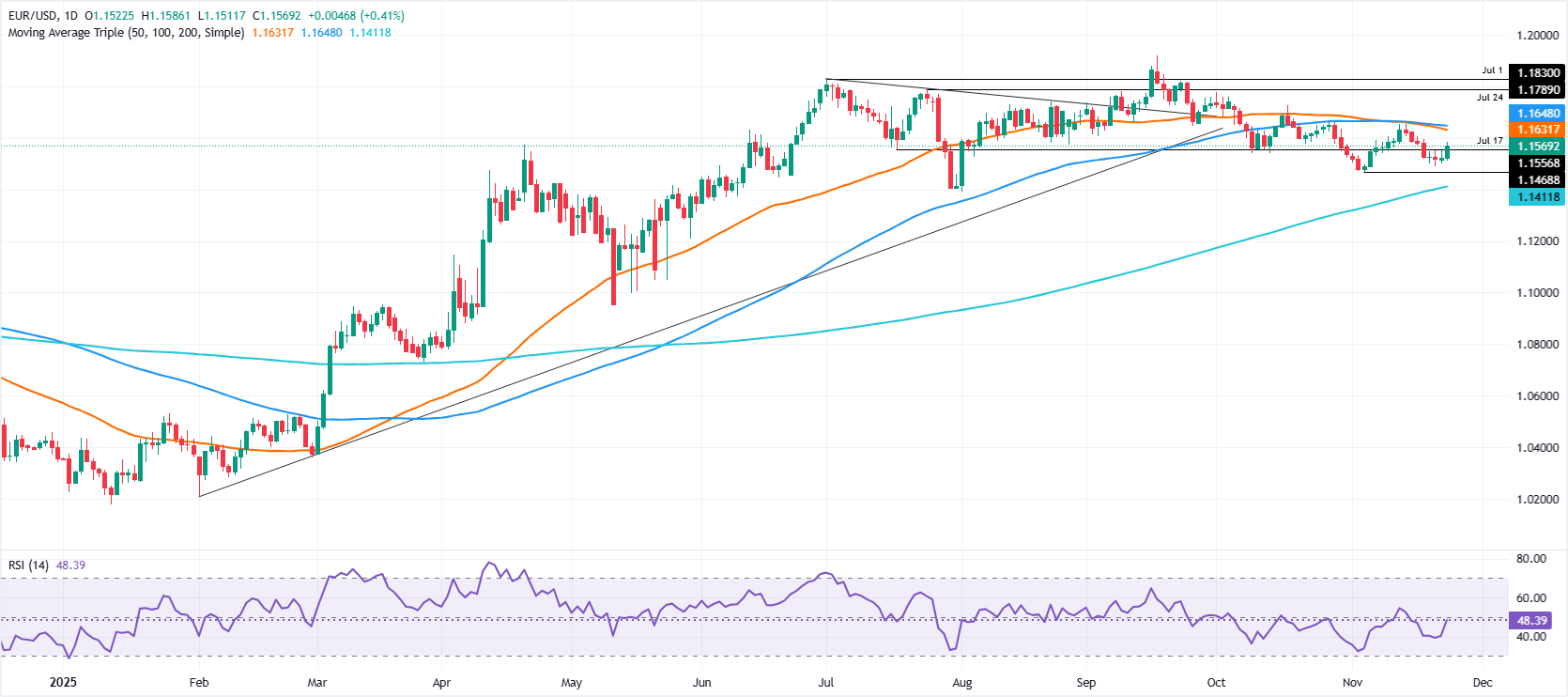Euro strengthens on softer US figures, dovish repricing intensifies
- EUR/USD edges higher as steady PPI and weak Retail Sales boost expectations of a December Fed cut.
- US Consumer Confidence drops sharply amid pessimism on jobs, incomes, and financial outlook during shutdown.
- German GDP meets expectations, showing stagnant Q3 but offering little resistance to Euro’s advance.
EUR/USD registers solid gains of over 0.51% on Tuesday, boosted by a weaker US Dollar, as data reinforced traders’ speculation that the Federal Reserve might reduce rates at the December meeting. At the time of writing, the pair trades at 1.1579, getting close to the 1.1600 figure.
Euro surges as weak US inflation, confidence data boost bets on a December Fed cut
The shared currency extended its gains as US economic data showed that inflation is edging lower, that consumers are reducing their expenses and that they are also turning pessimistic about the jobs market, incomes and the financial situation.
The Producer Price Index (PPI) stabilized in September, revealed the Bureau of Labor Statistics (BLS). Retail Sales dipped yet remained in positive territory in September, showed the Census Bureau,
Later, the November’s Conference Board (CB) Consumer Confidence showed that households are turning pessimistic, falling the most since April mostly influenced by the US government shutdown.
Across the pond, Gross Domestic Product (GDP) figures in Germany were aligned with estimates and with the previous month figures, an indication that the economy stagnated in the third quarter of 2025.
Euro Price This week
The table below shows the percentage change of Euro (EUR) against listed major currencies this week. Euro was the strongest against the US Dollar.
| USD | EUR | GBP | JPY | CAD | AUD | NZD | CHF | |
|---|---|---|---|---|---|---|---|---|
| USD | -0.46% | -0.49% | -0.33% | -0.03% | -0.20% | -0.14% | -0.13% | |
| EUR | 0.46% | -0.03% | 0.14% | 0.43% | 0.25% | 0.34% | 0.33% | |
| GBP | 0.49% | 0.03% | 0.16% | 0.49% | 0.28% | 0.35% | 0.36% | |
| JPY | 0.33% | -0.14% | -0.16% | 0.29% | 0.06% | 0.05% | 0.19% | |
| CAD | 0.03% | -0.43% | -0.49% | -0.29% | -0.17% | -0.12% | -0.11% | |
| AUD | 0.20% | -0.25% | -0.28% | -0.06% | 0.17% | 0.07% | 0.09% | |
| NZD | 0.14% | -0.34% | -0.35% | -0.05% | 0.12% | -0.07% | 0.00% | |
| CHF | 0.13% | -0.33% | -0.36% | -0.19% | 0.11% | -0.09% | -0.01% |
The heat map shows percentage changes of major currencies against each other. The base currency is picked from the left column, while the quote currency is picked from the top row. For example, if you pick the Euro from the left column and move along the horizontal line to the US Dollar, the percentage change displayed in the box will represent EUR (base)/USD (quote).
Daily market movers: EUR/USD advances as US inflation edge lower
- The US Dollar Index (DXY). which tracks the buck’s performance versus six currencies, falls 0.37% below the 100.00 mark at 99.81.
- The US Producer Price Index (PPI) remained steady at 2.7% YoY in September, matching expectations and August’s reading and suggesting that inflationary pressures have stabilized. Core PPI eased to 2.6% from 2.9%, undershooting forecasts of 2.7%.
- Retail Sales rose by 0.2% MoM in September, slowing from the 0.6% increase seen in August, indicating more cautious consumer spending. Separately, the Conference Board reported a sharp deterioration in household sentiment, with Consumer Confidence sliding 6.8 points to 88.7 in November from 95.5 in October.
- In Germany, the economy stalled in Q3, with the preliminary print coming at 0% QoQ. On a yearly basis, GDP was 0.3% as expected, matching the previous reading. Nevertheless, the Eurozone’s largest economy continued to show weakness.
- Ahead this week, traders eye the release of economic data, particularly Wednesday’s Initial Jobless Claims, moved in observance of the Thanksgiving holiday.
Technical Outlook: EUR/USD clears 20-day SMA, eyes on 1.1600
EUR/USD resumed its uptrend, clearing the 20-day Simple Moving Average (SMA) at 1.1556, yet it remains shy of extending its gains. If the pair clears 1.1600 would face key resistance like the confluence of the 50- and 100-day SMAs at 1.1631/1.1646 ahead of 1.1700.
On the other hand, a drop below 1.1550 could push prices towards 1.1500 and below. The next support would be the November 5 low at 1.1468 and the 200-day SMA near 1.1409.

Euro FAQs
The Euro is the currency for the 20 European Union countries that belong to the Eurozone. It is the second most heavily traded currency in the world behind the US Dollar. In 2022, it accounted for 31% of all foreign exchange transactions, with an average daily turnover of over $2.2 trillion a day. EUR/USD is the most heavily traded currency pair in the world, accounting for an estimated 30% off all transactions, followed by EUR/JPY (4%), EUR/GBP (3%) and EUR/AUD (2%).
The European Central Bank (ECB) in Frankfurt, Germany, is the reserve bank for the Eurozone. The ECB sets interest rates and manages monetary policy. The ECB’s primary mandate is to maintain price stability, which means either controlling inflation or stimulating growth. Its primary tool is the raising or lowering of interest rates. Relatively high interest rates – or the expectation of higher rates – will usually benefit the Euro and vice versa. The ECB Governing Council makes monetary policy decisions at meetings held eight times a year. Decisions are made by heads of the Eurozone national banks and six permanent members, including the President of the ECB, Christine Lagarde.
Eurozone inflation data, measured by the Harmonized Index of Consumer Prices (HICP), is an important econometric for the Euro. If inflation rises more than expected, especially if above the ECB’s 2% target, it obliges the ECB to raise interest rates to bring it back under control. Relatively high interest rates compared to its counterparts will usually benefit the Euro, as it makes the region more attractive as a place for global investors to park their money.
Data releases gauge the health of the economy and can impact on the Euro. Indicators such as GDP, Manufacturing and Services PMIs, employment, and consumer sentiment surveys can all influence the direction of the single currency. A strong economy is good for the Euro. Not only does it attract more foreign investment but it may encourage the ECB to put up interest rates, which will directly strengthen the Euro. Otherwise, if economic data is weak, the Euro is likely to fall. Economic data for the four largest economies in the euro area (Germany, France, Italy and Spain) are especially significant, as they account for 75% of the Eurozone’s economy.
Another significant data release for the Euro is the Trade Balance. This indicator measures the difference between what a country earns from its exports and what it spends on imports over a given period. If a country produces highly sought after exports then its currency will gain in value purely from the extra demand created from foreign buyers seeking to purchase these goods. Therefore, a positive net Trade Balance strengthens a currency and vice versa for a negative balance.

